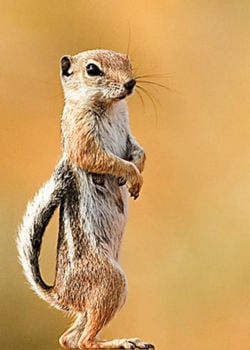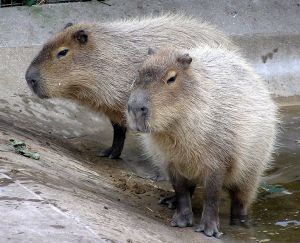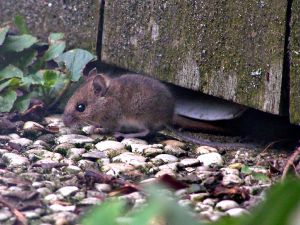Rodent
| Rodents
| ||||||||||||||
|---|---|---|---|---|---|---|---|---|---|---|---|---|---|---|
 Ammospermophilus leucurus
| ||||||||||||||
| Scientific classification | ||||||||||||||
| ||||||||||||||
|
Sciuromorpha |
Rodentia is an order of mammals also known as rodents.
Size and range of order
In terms of number of species — although not necessarily in terms of number of organisms (population) or biomass — rodents make up the largest order of mammals, with over 40 percent of mammalian species belonging to the order.[1] Their success is probably due to their small size, short breeding cycle, and ability to gnaw and eat a wide variety of foods.(Lambert, 2000)
There are between 2000 and 3000 species of rodents, which are found in vast numbers on all continents except Antarctica, most islands, and in all habitats except for oceans. They are the only placental order other than bats (Chiroptera) to reach Australia without human introduction.
Characteristics

Most rodents are small; the tiny African pygmy mouse is only 6 cm in length and 7 grams in weight. On the other hand, the capybara can weigh up to 45 kg (100 pounds) and the extinct Phoberomys pattersoni is believed to have weighed 700 kg.
Rodents have two incisors in the upper as well as in the lower jaw which grow continuously and must be kept worn down by gnawing; this is the origin of the name, from the Latin rodere, to gnaw, and dens, dentis, tooth. These teeth are used for cutting wood, biting through the skin of fruit, or for defense. The teeth have enamel on the outside and exposed dentine on the inside, so they self-sharpen during gnawing. Rodents lack canines, and have a space between their incisors and premolars. Nearly all rodents feed on plants, seeds in particular, but there are a few exceptions which eat insects or even fish.
Rodents are important in many ecosystems because they reproduce rapidly, and can function as food sources for predators, mechanisms for seed dispersal, and as disease vectors. Humans use rodents as a source of fur, as model organisms in animal testing, for food, and even in detecting landmines[2].
Members of non-rodent orders such as Chiroptera (bats), Scandentia (treeshrews), Insectivora (moles, shrews and hedgehogs), Lagomorpha (hares, rabbits and pikas) and mustelid carnivores such as weasels and mink are sometimes confused for rodents. Rodents have a carrier-immunity to rabies virus, making them immune to the potentially infectious and lethal disease. They are carriers for most other animal-to-human illnesses, however, and still should not be agitated.
Natural history
The fossil record of rodents begins long before the extinction of the dinosaurs 65 million years ago, as early as the Jurassic Period. By the end of the Eocene epoch, beavers and squirrels appeared in the fossil record. They originated in Laurasia, the joined continents of North America, Europe, and Asia. Some species colonized Africa, giving rise to the earliest hystricognaths. From there they rafted to South America, an isolated continent during the Oligocene and Miocene epochs. By the Miocene, Africa collided with Asia, allowing rodents such as porcupines to spread into Eurasia. During the Pliocene, rodent fossils appeared in Australia. Even though marsupials are the prominent mammals in Australia, rodents make up almost 25% of the mammals on the continent. Meanwhile, the Americas became joined and some rodents expanded into new territory; mice headed south and porcupines headed north.
- Some Prehistoric Rodents
- Castoroides, a giant beaver
- Ceratogaulus, a horned burrowing rodent
- Flores Giant Rat, a rat that grew to a large size on the island of Flores
- Giant hutias, a group of rodents once found in the West Indies
- Ischyromys, a primitive squirrel-like rodent
- Leithia, a giant dormouse
- Neochoerus pinckneyi, a giant North American capybara that weighed 50 kg
- Phoberomys pattersoni, the largest known rodent
- Telicomys, a giant South American rodent
Classification
The rodents are part of the clades: Glires (along with lagomorphs), Euarchontoglires (along with lagomorphs, primates, treeshrews, and colugos), and Boreoeutheria (along with most other placental mammals). The order Rodentia may be divided into suborders, infraorders, superfamilies and families.
Classification scheme:
ORDER RODENTIA (from Latin, rodere, to gnaw)
- Suborder Sciuromorpha
- Suborder Castorimorpha
- Superfamily Castoroidea
- Family Castoridae: beavers
- Superfamily Geomyoidea
- Family Heteromyidae: kangaroo rats and kangaroo mice
- Family Geomyidae: pocket gophers (true gophers)
- Superfamily Castoroidea
- Suborder Myomorpha
- Superfamily Dipodoidea
- Family Dipodidae: jerboas and jumping mice
- Superfamily Muroidea
- Family Platacanthomyidae: spiny dormice
- Family Spalacidae: mole rats, bamboo rats, and zokors
- Family Calomyscidae: mouse-like hamsters
- Family Nesomyidae: climbing mice, rock mice, white-tailed rat, Malagasy rats and mice
- Family Cricetidae: hamsters, New World rats and mice, voles
- Family Muridae: true mice and rats, gerbils, spiny mice, crested rat
- Superfamily Dipodoidea
- Suborder Anomaluromorpha
- Family Anomaluridae: scaly-tailed squirrels
- Family Pedetidae: springhares
- Suborder Hystricomorpha
- Family incertae sedis Diatomyidae: Laotian rock rat
- Infraorder Ctenodactylomorphi
- Family Ctenodactylidae: gundis
- Infraorder Hystricognathi
- Family Hystricidae: Old World porcupines
- Family Erethizontidae: New World porcupines
- Family Thryonomyidae: cane rats
- Family Petromuridae: dassie rat
- Family Bathyergidae: African mole rats
- Parvorder Caviomorpha
- Family Octodontidae: octodonts
- Family Echimyidae: spiny rats
- Family Capromyidae: hutias
- Family †Heptaxodontidae: giant hutias
- Family Myocastoridae: nutria
- Family Dasyproctidae: agoutis
- Family Dinomyidae: pacaranas
- Family Caviidae: cavies, including guinea pigs
- Family Hydrochoeridae: Capybara
- Family Chinchillidae: chinchillas and viscachas
- Family Abrocomidae: chinchilla rats
- Family Ctenomyidae: tuco-tucos
Alternate classifications
The above taxonomy uses the shape of the lower jaw (sciurognath or hystricognath) as the primary character. This is the most commonly used approach for dividing the order into suborders. Many older references emphasize the zygomasseteric system (suborders Protrogomorpha, Sciuromorpha, Hystricomorpha, and Myomorpha).
Several molecular phylogenetic studies have used gene sequences to determine the relationships among rodents, but these studies are yet to produce a single consistent and well-supported taxonomy. Some clades have been consistently produced such as:
- Ctenohystrica contains:
- Ctenodactylidae (gundis)
- Hystricognathi containing:
- Hystricidae
- An unnamed clade containing:
- Phiomorpha
- Caviomorpha
- Myodonta includes:
- Dipodoidea
- Muroidea
The positions of the Castoridae, Geomyoidea, Anomaluridae, and Pedetidae are still being debated.
Notes
- ↑ Myers, Phil (2000). Rodentia. Animal Diversity Web. University of Michigan Museum of Zoology. Retrieved 2006-05-25.
- ↑ Wines, Michael, "Gambian rodents risk death for bananas", The Age, The Age Company Ltd., 2004-05-19. Retrieved 2006-05-25. "A rat with a nose for landmines is doing its bit for humanity" Cited as coming from the New York Times in the article.
ReferencesISBN links support NWE through referral fees
- Adkins, R. M. E. L. Gelke, D. Rowe, and R. L. Honeycutt. 2001. Molecular phylogeny and divergence time estimates for major rodent groups: Evidence from multiple genes. Molecular Biology and Evolution, 18:777-791.
- Carleton, M. D. and G. G. Musser. 2005. Order Rodentia. Pp 745-752 in Mammal Species of the World A Taxonomic and Geographic Reference. John Hopkins University Press, Baltimore.
- David Lambert and the Diagram Group. The Field Guide to Prehistoric Life. New York: Facts on File Publications, 1985. ISBN 0-8160-1125-7
- Leung LKP, Peter G. Cox, Gary C. Jahn and Robert Nugent. 2002. Evaluating rodent management with Cambodian rice farmers. Cambodian Journal of Agriculture Vol. 5, pp. 21-26.
- Nowak, R. M. 1999. Walker's Mammals of the World, Vol. 2. Johns Hopkins University Press, London.
- Steppan, S. J., R. A. Adkins, and J. Anderson. 2004. Phylogeny and divergence date estimates of rapid radiations in muroid rodents based on multiple nuclear genes. Systematic Biology, 53:533-553.
| Mammals |
|---|
| Monotremata (platypus, echidnas) |
|
Marsupialia: | Paucituberculata (shrew opossums) | Didelphimorphia (opossums) | Microbiotheria | Notoryctemorphia (marsupial moles) | Dasyuromorphia (quolls and dunnarts) | Peramelemorphia (bilbies, bandicoots) | Diprotodontia (kangaroos and relatives) |
|
Placentalia: Cingulata (armadillos) | Pilosa (anteaters, sloths) | Afrosoricida (tenrecs, golden moles) | Macroscelidea (elephant shrews) | Tubulidentata (aardvark) | Hyracoidea (hyraxes) | Proboscidea (elephants) | Sirenia (dugongs, manatees) | Soricomorpha (shrews, moles) | Erinaceomorpha (hedgehogs and relatives) Chiroptera (bats) | Pholidota (pangolins)| Carnivora | Perissodactyla (odd-toed ungulates) | Artiodactyla (even-toed ungulates) | Cetacea (whales, dolphins) | Rodentia (rodents) | Lagomorpha (rabbits and relatives) | Scandentia (treeshrews) | Dermoptera (colugos) | Primates | |
|
Sciuromorpha: †Allomyidae | Aplodontiidae | †Mylagaulidae | †Reithroparamyidae | Sciuridae | Gliridae |
|
Castorimorpha: †Eutypomyidae | Castoridae | †Rhizospalacidae | †Eomyidae | †Heliscomyidae | †Mojavemyidae | Heteromyidae | Geomyidae |
|
Myomorpha: †Armintomidae | Dipodidae | Zapodidae | †Anomalomyidae | †Simimyidae | Platacanthomyidae | Spalacidae | Calomyscidae | Nesomyidae | Cricetidae | Muridae |
|
Anomaluromorpha: Anomaluridae | †Parapedetidae | Pedetidae |
|
Hystricomorpha: †Tamquammyidae | Ctenodactylidae | Diatomyidae | †Yuomyidae | †Chapattimyidae | †Tsaganomyidae | †"Baluchimyinae" | †Bathyergoididae | Bathyergidae | Hystricidae | †Myophiomyidae | †Diamantomyidae | †Phiomyidae | †Kenyamyidae | Petromuridae | Thryonomyidae | Erethizontidae | Chinchillidae | Dinomyidae | Caviidae | Dasyproctidae | †Eocardiidae | Cuniculidae | Ctenomyidae | Octodontidae | †Neoepiblemidae | Abrocomidae | Echimyidae | Myocastoridae | Capromyidae | †Heptaxodontidae |
|
Prehistoric rodents (incertae sedis): †Eurymylidae | †Cocomyidae | †Alagomyidae | †Ivanantoniidae | †Laredomyidae | †Ischyromyidae | †Theridomyidae | †Protoptychidae | †Zegdoumyidae | †Sciuravidae | †Cylindrodontidae |
|
† indicates extinct taxa |
Credits
New World Encyclopedia writers and editors rewrote and completed the Wikipedia article in accordance with New World Encyclopedia standards. This article abides by terms of the Creative Commons CC-by-sa 3.0 License (CC-by-sa), which may be used and disseminated with proper attribution. Credit is due under the terms of this license that can reference both the New World Encyclopedia contributors and the selfless volunteer contributors of the Wikimedia Foundation. To cite this article click here for a list of acceptable citing formats.The history of earlier contributions by wikipedians is accessible to researchers here:
The history of this article since it was imported to New World Encyclopedia:
Note: Some restrictions may apply to use of individual images which are separately licensed.
